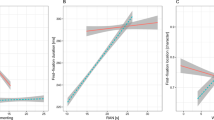Abstract
Language plays an important role in word problem solving. Accordingly, the language in which a word problem is presented could affect its solution process. In particular, East-Asian, non-alphabetic languages are assumed to provide specific benefits for mathematics compared to Indo-European, alphabetic languages. By analyzing students’ eye movements in a cross-linguistic comparative study, we analyzed word problem solving processes in Chinese and German. 72 German and 67 Taiwanese undergraduate students solved PISA word problems in their own language. Results showed differences in eye movements of students, between the two languages. Moreover, independent cluster analyses revealed three clusters of reading patterns based on eye movements in both languages. Corresponding reading patterns emerged in both languages that were similarly and significantly associated with performance and motivational-affective variables. They explained more variance among students in these variables than between the languages alone. Our analyses show that eye movements of students during reading differ between the two languages, but very similar reading patterns exist in both languages. This result supports the assumption that the language alone is not a sufficient explanation for differences in students’ mathematical achievement, but that reading patterns are more strongly related to performance.

(Adapted from PISA 2012 Released Mathematics Items (p. 20), by OECD (2013b). Copyright (2013) by the OECD. Used under CC BY-NC-SA 3.0 IGO)


Similar content being viewed by others
Notes
These differences are not specific to the English language but can be generalized to Indo-European languages.
Eye movements of the right eye were recorded on a 22-inch screen with a resolution of 1680 × 1056 pixels in a distance of about 70 cm. 5-point calibration was repeated until a deviation of less than 1.0° was reached. If that was not accomplished after three tries, the smallest deviation was used, and the data were checked afterwards to ensure tracking quality. For detection of eye movement events, only text was included in the analysis while pictures, tables and graphs were omitted. We used an I-DT algorithm for fixation detection (Salvucci and Goldberg 2000). We employed a minimum fixation time of 100 ms and a maximum deviation threshold of approximately 4.5° (200 px; Blignaut 2009). Fixations longer than 500 ms were omitted (Rayner 1998). Blinks were counted between 70 and 1000 ms (Holmqvist et al. 2011). Saccades were counted as regressions if they were directed forward and more than 20 px upward or were directed backward and less then 5 px downward. This corresponds to the type size and the interline spacing, respectively. Saccade length was only considered for saccades within a forward directed window of ± 20 px.
References
Abedi, J. (2006). Language issues in item-development. In S. M. Downing & T. M. Haladyna (Eds.), Handbook of test development (pp. 377–398). Mahwah: Erlbaum.
Aiken, L. R. (1972). Language factors in learning mathematics. Review of Educational Research,42, 359–385.
Andersson, U. (2007). The contribution of working memory to children’s mathematical word problem solving. Applied Cognitive Psychology,21, 1201–1216. https://doi.org/10.1002/acp.1317.
Blignaut, P. (2009). Fixation identification: the optimum threshold for a dispersion algorithm. Attention, Perception & Psychophysics,71(4), 881–895. https://doi.org/10.3758/APP.71.4.881.
Boonen, A. J. H., de Koning, B. B., Jolles, J., & van der Schoot, M. (2016). Word problem solving in contemporary math education: A plea for reading comprehension skills training. Frontiers in Psychology,7, 191. https://doi.org/10.3389/fpsyg.2016.00191.
Clifton, C., Ferreira, F., Henderson, J. M., Inhoff, A. W., Liversedge, S. P., Reichle, E. D., et al. (2016). Eye movements in reading and information processing: Keith Rayner’s 40 year legacy. Journal of Memory and Language,86, 1–19. https://doi.org/10.1016/j.jml.2015.07.004.
Cummins, D. D., Kintsch, W., Reusser, K., & Weimer, R. (1988). The role of understanding in solving word problems. Cognitive Psychology,20(4), 405–438.
Daroczy, G., Wolska, M., Meurers, W. D., & Nuerk, H. C. (2015). Word problems: A review of linguistic and numerical factors contributing to their difficulty. Frontiers in Psychology,6, 348. https://doi.org/10.3389/fpsyg.2015.00348.
De Corte, E., Verschaffel, L., & Pauwels, A. (1990). Influence of the semantic structure of word problems on second graders’ eye movements. Journal of Educational Psychology,82(2), 359–365. https://doi.org/10.1037/0022-0663.82.2.359.
de Koning, B. B., Boonen, A. J. H., & van der Schoot, M. (2017). The consistency effect in word problem solving is effectively reduced through verbal instruction. Contemporary Educational Psychology,49, 121–129. https://doi.org/10.1016/j.cedpsych.2017.01.006.
Engeser, S., & Rheinberg, F. (2008). Flow, performance and moderators of challenge-skill balance. Motivation and Emotion,32(3), 158–172. https://doi.org/10.1007/s11031-008-9102-4.
Galligan, L. (2001). Possible effects of English-Chinese language differences on the processing of mathematical text: a review. Mathematics Education Research Journal,13(2), 112–132. https://doi.org/10.1007/BF03217102.
Grisay, A., de Jong, J. H. A. L., Gebhardt, E., Berezner, A., & Halleux-Monseur, B. (2007). Translation equivalence across PISA countries. Journal of Applied Measurement,8(3), 249–266.
Hegarty, M., Mayer, R. E., & Green, C. E. (1992). Comprehension of arithmetic word problems: Evidence from students’ eye fixations. Journal of Educational Psychology,84(1), 76–84. https://doi.org/10.1037/0022-0663.87.1.18.
Hegarty, M., Mayer, R. E., & Monk, C. A. (1995). Comprehension of arithmetic word problems: A comparison of successful and unsuccessful problem solvers. Journal of Educational Psychology,87(1), 18–32. https://doi.org/10.1037/0022-0663.87.1.18.
Holmqvist, K., Nyström, M., Andersson, R., Dewhurst, R., Jarodzka, H., & van de Weijer, J. (2011). Eye tracking: A comprehensive guide to methods and measures. Oxford: Oxford University Press.
Just, M. A., & Carpenter, P. A. (1980). A theory of reading: From eye fixations to comprehension. Psychological Review,87, 329–354. https://doi.org/10.1037/0033-295X.87.4.329.
Kintsch, W., & Greeno, J. G. (1985). Understanding and solving word arithmetic problems. Psychological Review,92(1), 109–129.
Landhäußer, A., & Keller, J. (2012). Flow and its affective, cognitive, and performance-related consequences. In S. Engeser (Ed.), Advances in flow research (pp. 65–85). New York: Springer.
Leiss, D., Plath, J., & Schwippert, K. (2019). Language and mathematics—key factors influencing the comprehension process in reality-based tasks. Mathematical Thinking and Learning,1, 1. https://doi.org/10.1080/10986065.2019.1570835.
Leiss, D., Schukajlow, S., Blum, W., Messner, R., & Pekrun, R. (2010). The role of the situation model in mathematical modelling—task analyses, student competencies, and teacher interventions. Journal für Mathematik-Didaktik,31(1), 119–141. https://doi.org/10.1007/s13138-010-0006-y.
Leung, F.K.S. (2017). Making sense of mathematics achievement in East Asia: Does culture really matter? In G. Kaiser (Ed.), Proceedings of the 13th Internatioal Congress on Mathematical Education (pp. 201–218). Cham: Springer.
Lewis, A. B., & Mayer, R. E. (1987). Students’ miscomprehension of relational statements in arithmetic word problems. Journal of Educational Psychology,81, 521–531. https://doi.org/10.1037/0022-0663.79.4.363.
Liu, I. M. (1986). Chinese cognition. In M. Bond (Ed.), The psychology of the Chinese people (pp. 73–102). Hong Kong: Oxford University Press.
Maffei, A., & Angrilli, A. (2018). Spontaneous eye blink rate: An index of dopaminergic component of sustained attention and fatigue. International Journal of Psychophysiology,123, 58–63. https://doi.org/10.1016/j.ijpsycho.2017.11.009.
Mojena, R. (1977). Hierarchical clustering methods and stopping rules: An evaluation. The Computer Journal,20(4), 359–363. https://doi.org/10.1093/comjnl/20.4.359.
Moreau, S., & Coquin-Viennot, D. (2003). Comprehension of arithmetic word problems by fifth-grade pupils: Representations and selection of information. British Journal of Educational Psychology,73(1), 109–121. https://doi.org/10.1348/000709903762869941.
Morgan, C., Craig, T. S., Schuette, M., & Wagner, D. (2014). Language and communication in mathematics education: An overview of research in the field. ZDM Mathematics Education,46, 843–853. https://doi.org/10.1007/s11858-014-0624-9.
Nathan, M. J., Kintsch, W., & Young, E. (1992). A theory of algebra-word-problem comprehension and its implications for the design of learning environments. Cognition and Instruction,9(4), 329–389. https://doi.org/10.1207/s1532690xci0904_2.
Nesher, P., & Teubal, E. (1975). Verbal cues as an interfering factor in verbal problem solving. Educational Studies in Mathematics,6, 41–51. https://doi.org/10.1007/BF590023.
Ng, S. S. N., & Rao, N. (2010). Chinese number words, culture, an mathematics learning. Review of Educational Research,80(2), 180–206. https://doi.org/10.3102/0034654310364764.
OECD. (2005). PISA 2003 technical report. http://www.oecd.org/edu/school/programmeforinternationalstudentassessmentpisa/35188570.pdf. Accessed 18 June 2019.
OECD. (2013a). PISA 2012 Released mathematics items. https://www.oecd.org/pisa/pisaproducts/pisa2012-2006-rel-items-maths-ENG.pdf. Accessed 18 June 2019.
OECD. (2013b). PISA 2012 results: Ready to learn: Students’ engagement, drive and self-beliefs (Volume III): Pisa. Paris: OECD Publishing.
OECD. (2016a). PISA 2015 assessment and analytical framework: Science, reading, mathematic and financial literacy. Paris: PISA, OECD Publishing.
OECD. (2016b). PISA 2015 results (Volume I): Excellence and equity in education. Paris: PISA, OECD Publishing.
Pape, S. J. (2004). Middle school childrens’ problem-solving behaviour: A cognitive analysis from a reading comprehension perspective. Journal for Research in Mathematics Education,35(3), 187–219. https://doi.org/10.2307/30034912.
Rayner, K. (1998). Eye movements in reading and information processing: 20 years of research. Psychological Bulletin,124(3), 372–422. https://doi.org/10.1037/0033-2909.124.3.372.
Rayner, K., Pollatsek, A., Ashby, J., & Clifton, C. (2012). Psychology of reading (2nd ed.). New York: Psychology Press.
Reusser, K. (1990). From text to situation to equation: Cognitive simulation of understanding and solving mathematical word problems. In H. Mandl, E. De Corte, N. S. Bennett, & H. F. Friedrich (Eds.), Learning and instruction in an international context (pp. 477–498). New York: Pergamon.
Salvucci, D.D., & Goldberg, J.H. (2000). Identifying fixations and saccades in eye-tracking protocols. In Proceedings of the eye tracking research and applications symposium (pp. 71–78). New York: ACM Press.
Schiepe-Tiska, A., & Engeser, S. (2017). Measuring flow at work. In C. J. Fullagar & A. delle Fave (Eds.), Flow at work. Measurement and implications (pp. 28–49). New York: Routledge.
Schiepe-Tiska, A., Roczen, N., Müller, K., Prenzel, M., & Osborne, J. (2016). Science-related outcomes: Attitudes, motivation, value beliefs, strategies. In S. Kuger, E. Klieme, N. Jude, & D. Kaplan (Eds.), Assessing context of learning. An international perspective (pp. 301–330). New York: Springer.
Seah, W. T., & Wong, N. Y. (2012). Thematic issue on values in East Asian mathematics education—the third wave. ZDM Mathematics Education,44(1), 1–2. https://doi.org/10.1007/s11858-012-0402-5.
Strohmaier, A. R., Lehner, M. C., Beitlich, J. T., & Reiss, K. M. (2019a). Eye movements during mathematical word problem solving—global measures and individual differences. Journal für Mathematik-Didaktik. https://doi.org/10.1007/s13138-019-00144-0.
Strohmaier, A. R., MacKay, K. J., Obersteiner, A., & Reiss, K. M. (2019). Eye tracking methodology in mathematics education research: A systematic literature review. (Manuscript submitted for publication).
Strohmaier, A. R., Schiepe-Tiska, A., Müller, F., & Reiss, K. (2017). Mathematical reading patterns—the influence of self-concept and situational context. Paper presented at the Annual Meeting of the American Educational Research Association (AERA), San Antonio (TX), USA.
Sun, F., & Feng, D. (1999). Eye movements in reading Chinese and English text. In J. Wang, A. W. Inhoff, & H.-C. Chen (Eds.), Reading Chinese script: A cognitive analysis (pp. 189–206). Mahwah: Lawrence Erlbaum.
van der Schoot, M., Bakker Arkema, A. H., Horsley, T. M., & van Lieshout, E. C. D. M. (2009). The consistency effect depends on markedness in less successful but not succesful problem solvers: An eye movement study in primary school children. Contemporary Educational Psychology,34, 58–66. https://doi.org/10.1016/j.cedpsych.2008.07.002.
Verschaffel, L., De Corte, E., & Pauwels, A. (1992). Solving compare problems: An eye movement test of Lewis and Mayer’s consistency hypothesis. Journal of Educational Psychology,84(1), 85–94. https://doi.org/10.1037/0022-0663.84.1.85.
Verschaffel, L., Greer, B., & De Corte, E. (2000). Making sense of word problems. Lisse: Swets & Zeitlinger.
Vicente, S., Orrantia, J., & Verschaffel, L. (2007). Influence of situational rewording and conceptual rewording on word problem solving. British Journal of Educational Psychology,77, 829–848. https://doi.org/10.1348/000709907X178200.
Zang, C., Liversedge, S. P., Bai, X., & Yan, G. (2011). Eye-movements during Chinese reading. In S. P. Liversedge, I. D. Gilchrist, & S. Everling (Eds.), The Oxford handbook of eye-movements (pp. 961–978). Oxford: Oxford University Press.
Author information
Authors and Affiliations
Corresponding author
Additional information
Publisher's Note
Springer Nature remains neutral with regard to jurisdictional claims in published maps and institutional affiliations.
Rights and permissions
About this article
Cite this article
Strohmaier, A.R., Schiepe-Tiska, A., Chang, YP. et al. Comparing eye movements during mathematical word problem solving in Chinese and German. ZDM Mathematics Education 52, 45–58 (2020). https://doi.org/10.1007/s11858-019-01080-6
Accepted:
Published:
Issue Date:
DOI: https://doi.org/10.1007/s11858-019-01080-6




